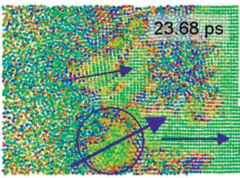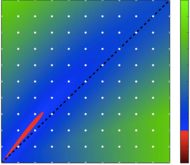Molecular dynamics simulations of shock-induced deformation twinning of a body-centered-cubic metal
A. Higginbotham,
M. J. Suggit,
E. M. Bringa,
P. Erhart,
J. A. Hawreliak,
G. Mogni,
N. Park,
B. A. Remington,
and
J. S. Wark
Physical Review B 88, 104105
(2013)
doi: 10.1103/PhysRevB.88.104105
Despite a number of previous nonequilibrium molecular dynamics (MD) studies into plasticity in face-centered-cubic metals, and phase transitions in body-centered-cubic (bcc) metals, the plastic response to rapid compression of bcc metals remains largely unexplored. Key questions remain as to the relative importance of dislocation motion and twinning in shear stress release and consequent strength. We present here large scale MD simulations of shock compressed bcc metal, using an extended Finnis-Sinclair potential for tantalum, and demonstrate the presence of significant deformation twinning for pressures above the Hugoniot elastic limit for shock waves propagating along the [001] direction. The twinned variants are separately identified by a per atom order parameter, allowing the strain and stress states of the rotated material to be studied. The atomic motion during twinning, and thus its mechanism, for this potential, is identified by use of a three-dimensional pair-correlation function.


